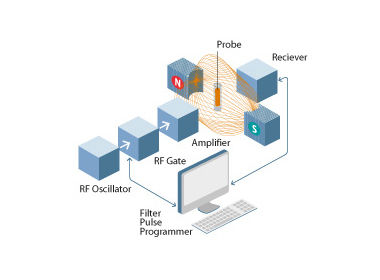Pour bénéficier d’un affichage optimal de la boutique en ligne de PanGas, vous avez besoin pour le navigateur de la version minimale suivante:
• Internet Explorer 9.0
• Mozilla Firefox 38
• Safari 8
• Chrome 45
Veuillez vous assurer que JavaScript est activé dans les paramètres de votre navigateur.
- Accueil
- Applications
- Analyse & Instrumentation
- Nuclear Magnetic Resonance
Nuclear Magnetic Resonance
Nuclear magnetic resonance (NMR) is based upon the measurement of absorption of radiofrequency (RF) radiation by a nucleus in a strong magnetic field. Absorption of the radiation causes the nuclear spin to realign or flip in the higher-energy direction. After absorbing energy the nuclei will re-emit RF radiation and return to the lower-energy state.
The principle of NMR is that nuclei with odd number of protons, neutrons or both will have an intrinsic nuclear spin. When a nucleus with a non-zero spin is placed in a magnetic field, the nuclear spin can align in either the same direction or in the opposite direction as the field. These two nuclear spin alignments have different energies and application of a magnetic field lifts the degeneracy of the nuclear spins. A nucleus that has its spin aligned with the field will have a lower energy than when it has its spin aligned in the opposite direction to the field.
The energy of a NMR transition depends on the magnetic-field strength and a proportionality factor for each nucleus called the magnetogyric ratio. The local environment around a given nucleus in a molecule will slightly perturb the local magnetic field exerted on that nucleus and affect its exact transition energy. This dependence of the transition energy on the position of a particular atom in a molecule makes NMR spectroscopy extremely useful for determining the structure of molecules.
NMR spectroscopy is one of the most powerful tools for elucidating the structure of both organic and inorganic species. It has also proven useful for the quantitative determination of absorbing species.
Instrumentation
There are two types of NMR spectrometers, continuous-wave (cw) and pulsed or Fourier-Transform (FT-NMR). Cw-NMR spectrometers have largely been replaced with pulsed FT-NMR instruments. However due to the lower maintenance and operating costs, cw instruments, they are still commonly used for routine 1H NMR spectroscopy. In low-resolution cw instruments electromagnets are cooled with water and magnets in FT-NMR spectrometers are cooled with liquid helium.
Continuous-wave Nuclear Magnetic Resonance
A continuous-wave NMR instrument consists of the following units: a magnet to separate the nuclear spin energy states; at least two radiofrequency channels, one for field/frequency stabilization and one to furnish RF irradiation energy; a sample probe containing coils for coupling the sample with the RF field; a detector to process the NMR signals; a sweep generator for sweeping either the magnetic or RF field through the resonance frequencies of the sample; and a recorder to display the spectrum.
The spectrum is scanned by the field-sweep method or the frequency-sweep method. In the frequency-sweep method, the magnetic field is held constant, which keeps the nuclear spin energy levels constant, then the RF signal is swept to determine the frequencies at which energy is absorbed. In the field sweep method, the RF signal is held constant, then the magnetic field is swept, which varies the energy levels, to determine the magnetic field strengths that produce resonance at fixed resonance frequency.

Fourier-Transform Nuclear Magnetic Resonance
Fourier-Transform NMR spectrometers use a pulse of radiofrequency radiation to cause nuclei in a magnetic field to flip into the higher-energy alignment. The length of the RF pulse is 1-10 µs and is wide enough to simultaneously excite nuclei in all local environments. The interval between pulses T is typically one to several seconds. During T, a time-domain RF signal called the free induction decay (FID) signal is emitted as nuclei return to their original state.
FID can be detected with a radio-receiver coil that is perpendicular to the static magnetic field. The FID signal is digitized and stored in a computer for data processing. Ordinary the time-domain decay signals from numerous successive pulses can be summed and averaged to improve the signal-to-noise ratio. The result is then converted to a frequency-domain signal by a Fourier transformation. The resulting frequency-domain output is similar to the spectrum produced by a scanning continuous-wave experiment.

